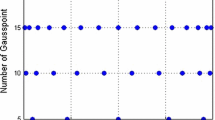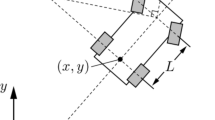Abstract
Vehicle-infrastructure cooperative systems can potentially enhance both traffic safety and efficiency by conducting coordinated control through the interactive strategy between the vehicles and the infrastructure. In this study, the interactive strategy of a vehicle infrastructure cooperative system is designed. Lane change maneuver is a conventional behavior in driving. Thus, this paper proposes a trajectory planning algorithm based on a Gauss pseudo-spectral method that is applied to the intelligent vehicle-infrastructure cooperative system in the lane change scenario. A road side unit calculates the planning trajectory using collected vehicle information and sensor data and then sends the trajectory planning advice to the designated vehicle. The Gauss pseudo-spectral method is used to obtain the planning trajectory, which effectively helps solve the discontinuous optimization problems in partial conditions. It transforms the optimal control problem of dynamic systems into a nonlinear programming problem using the orthogonal collocation method to discretize the objective function and various constraints of the optimization problem. Furthermore, the ssuential quadratic programming method is used to solve the problem numerically. The effectiveness of the proposed method and interactive strategy are demonstrated through simulations and experimental results.
Similar content being viewed by others
References
Blincoe, L., Miller, T. R., Zaloshnja, E. and Lawrence, B. A. (2015). The economic and societal impact of motor vehicle crashes. National Highway Traffic Safety Administration 66, 2, 194–196.
Darby, C. L., Hager, W. W. and Rao, A. V. (2011). An hp-adaptive pseudospectral method for solving optimal control problems. Optimal Control Applications & Methods 32, 4, 476–502.
Donahue, J., Hendricks, L. A., Rohrbach, M., Venugopalan, S., Guadarrama, S., Saenko, K. and Darrell, T. (2017). Long-term recurrent convolutional networks for visual recognition and description. IEEE Trans. Pattern Analysis & Machine Intelligence 39, 4, 677–691.
Gill, P. E. and Saunders, M. M. A. (2005). SNOPT: An SQP algorithm for large-scale constrained optimization. SIAM Review 47, 1, 99–131.
Gill, P. E. and Saunders, M. M. A (2012). tUser’ Guide for SNOPT Version 7: Software for Large-scale Nonlinear Programming. Stanford University.
Gong, Q., Fahroo, F. and Ross, I. M. (2008). Spectral algorithm for pseudospectral methods in optimal control. J. Guidance, Control, and Dynamics 31, 3, 460–471.
Habel, L. C. and Schreckenberg, M. (2014). Asymmetric lane change rules for a microscopic highway traffic model. Lecture Notes in Computer Science, 8751, 620–629.
Han, P., Shan, J. Y. and Meng, X. Y. (2013). Re-entry trajectory optimization using an hp-adaptive radau pseudospectral method. Beijing Institute of Technology 22, 1, 1623–1636.
Hong, B. X. and Wang, Q. (2012). Trajectory optimization of solid launch vehicle based on hp-adaptive pseudospectral method. Aerospace Control 30, 4, 18–31.
Hou, H., Hager, W. and Rao, A. (2015). Convergence of a gauss pseudospectral method for optimal control. AIAA Guidance, Navigation, & Control Conf, Minneapolis, Minnesota, USA.
Lee, K., Ahn, K. and Yoo, J. (2016). A novel P-norm correction method for lightweight topology optimization under maximum stress constraints. Computers & Structures, 171, 18–30.
Li, Y. F., Zhang, L. and Song, Y. (2016). A vehicular collision warning algorithm based on the time-to-collision estimation under connected environment. Proc. 14th Int. Conf. Control Automation Robotics and Vision (ICARCV), Phuket, Thailand.
Liu, N. and Han, J. (2018). A deep spatial contextual long-term recurrent convolutional network for saliency detection. IEEE Trans. Image Processing 27, 7, 3264–3274.
Mishra, P. K., Nath, S. K., Kosec, G and Sen, M. K. (2017). An improved radial basis-pseudospectral method with hybrid Gaussian-cubic kernels. Engineering Analysis with Boundary Elements, 80, 162–171.
Ran, B., Cheng, Y., Li, S., Ding, F., Jin, J., Chen, X and Zhang, Z. (2018). Connected Automated Vehicle Highway Systems and Methods. US Patent Application No. 15/628, 331.
Ran, B., Cheng, Y., Li, S., Zhang, Z., Ding, F., Tan, H., Wu, Y., Dong, S., Ye, L., Li, X., Chen, T., Shi, K., Jin, J. and Chen, X. (2019). Intelligent Road Infrastructure System (IRIS): Systems and Methods. US Patent Application No. 16/135, 916.
Rodemerk, C., Habenicht, S., Weitzel, A., Winner, H. and Schmitt, T. (2012). Development of a general criticality criterion for the risk estimation of driving situations and its application to a maneuver-based lane change assistance system. Proc. Intelligent Vehicles Symp., Alcala de Henares, Spain.
Ruiming, W. (2018). Research on Trajectory Planning of Wheeled Mobile Robot. M. S. Thesis. Harbin University of Science and Technology. Harbin, China.
Snider, J. M. (2009). Automatic Steering Methods for Autonomous Automobile Path Tracking. Ph. D. Dissertation. Carnegie Mellon University. Pittsburgh, Pennsylvania, USA.
Yang, G., Zhang, D. H., Li, G. Q. and Luo, Y. G (2017). Cooperative same-direction automated lane-changing based on vehicle-to-vehicle communication. J. Highway and Transportation Research and Development 34, 1, 120–129.
You, F., Zhang, R. H., Lie, G., Wang, H. W, Wen, H. and Xu, J. (2015). Trajectory planning and tracking control for autonomous lane change maneuver based on the cooperative vehicle infrastructure system. Expert Systems with Applications 42, 14, 5932–5946.
Wang, N., Er, M. J., Sun, J. C. and Liu, Y. C. (2015). Adaptive robust online constructive fuzzy control of a complex surface vehicle system. IEEE Trans. Cybernetics 46, 7, 1511–1523.
Zhang, W., Zhang, Y., Li, W. and Wang, Y. (2016). Path planning for rapid large-angle maneuver of satellites based on the gauss pseudospectral method. Mathematical Problems in Engineering, 2016, Article ID 1081267.
Zichao, H., Duanfeng, C., Chaozhong, W. and Yi, H. (2018). Path planning and cooperative control for automated vehicle platoon using hybrid automata. IEEE Trans. Intelligent Transportation Systems 20, 3, 959–974.
Acknowledgement
This research was funded by the Key-Area Research and Development Program of Guangdong Province [2019B090912001]
Author information
Authors and Affiliations
Corresponding author
Additional information
Publisher’s Note Springer Nature remains neutral with regard to jurisdictional claims in published maps and institutional affiliations.
Rights and permissions
About this article
Cite this article
Zhu, Y., Zhao, K., Li, H. et al. Trajectory Planning Algorithm Using Gauss Pseudo-Spectral Method Based on Vehicle-Infrastructure Cooperative System. Int.J Automot. Technol. 21, 889–901 (2020). https://doi.org/10.1007/s12239-020-0086-8
Received:
Revised:
Accepted:
Published:
Issue Date:
DOI: https://doi.org/10.1007/s12239-020-0086-8




